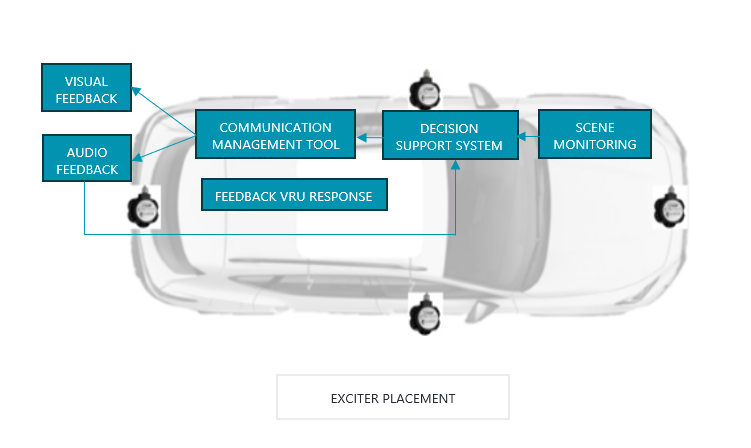Improving Pedestrian-Vehicle Communication with Acoustic and Visual Interfaces (eHMI)

The primary goal of AWARE2ALL is to tackle the new safety issues that arise with the introduction of highly autonomous vehicles in mixed traffic environments. This will be achieved by developing inclusive and innovative safety systems (both passive and active) and Human-Machine Interaction (HMI) systems, both external and internal. These systems will consider the diverse range of road users and will clearly show significant improvements in traffic safety. A key part of this project is to create an external HMI that can dynamically interact with nearby pedestrians.
Capgemini is developing a functional demonstrator to showcase the new interactions required for communication between autonomous vehicles (AVs) and human road users (HRUs), with a particular focus on vulnerable road users (VRUs). This initiative utilizes external Human-Machine Interfaces (eHMIs) that provide acoustic warnings, in compliance with Acoustic Vehicle Alerting Systems (AVAS) legislation. The goal is to enhance user experience and safety.
Three key use cases—parking, zebra-crossing, and pick-up—are part of the development and validation process. Capgemini’s approach emphasizes inclusivity, considering diverse user profiles, including different age groups, ethnicities, and individuals with reduced mobility (such as wheelchair users, those with crutches, and the visually impaired).
The Acoustic System incorporates a decision-making module which receives the information from the Vehicle Detection System. Consequently, the acoustic system generates customized messages based on pedestrian and environmental context, adjusting frequency, magnitude, and tone. These messages will be sent by several speakers, allowing them to send these messages in the correct way, to be more recognizable for the users, adjusting the volume, frequency and direction as is specified.
One of the main goals is to reduce response time to minimize the time it takes for pedestrians to react to vehicle messages. Achieving faster reactions improves safety and builds confidence among pedestrians. Another goal is to enhance pedestrian understanding of the system, ensuring they clearly comprehend the vehicle’s intentions. Intuitive visual and auditory signals need to be designed to convey vehicle actions. Better understanding reduces uncertainty and promotes cooperation.
Furthermore, it is essential to ensure a high level of satisfaction among pedestrians. Gathering feedback during real-world testing will help to refine the system. The effectiveness of the system will be validated by conducting usability tests with various disabled pedestrians. Real-world validation ensures practical success and user confidence.
The first step to define what kind of sounds and frequencies should be used to improve the recognition by the Vulnerable Road Users was to study the different tones, frequencies and how them affect to the different kind of people, taking in account his age, personal situation and focused on the Uses Cases that have been defined in this project.
To do this, different types of sounds have been analyzed depending on the material used for their creation (flutes, organ, xylophone, natural sounds...). In addition, the duration (continuous or intermittent), the frequency (low or high), the onset (sudden or gradual) and the evolution (increasing or decreasing) have been taken into account to facilitate the understanding of the message and send it in the direction of the HRU.
Finally, it has been determined the optimal location for the emitting devices in the car, considering the perception system and the sound transmission to the HRUs. It is decided to install them in various parts of the vehicle, as shown in the attached image. This allows the sound to be directed towards the specific location of the HRU when the vehicle needs to send them a message, making it easier to understand and achieving a faster and more effective reaction.

Aware2All eHMI delivers essential information clearly and understandably through visual and auditory messages, facilitating more rational and practical decisions. By incorporating external HMIs into vehicles, safety is enhanced through improved communication, clear information display, and better decision-making support. These systems significantly contribute to pedestrian and overall road safety by easing the movement of VRUs, vehicles, and pedestrians.